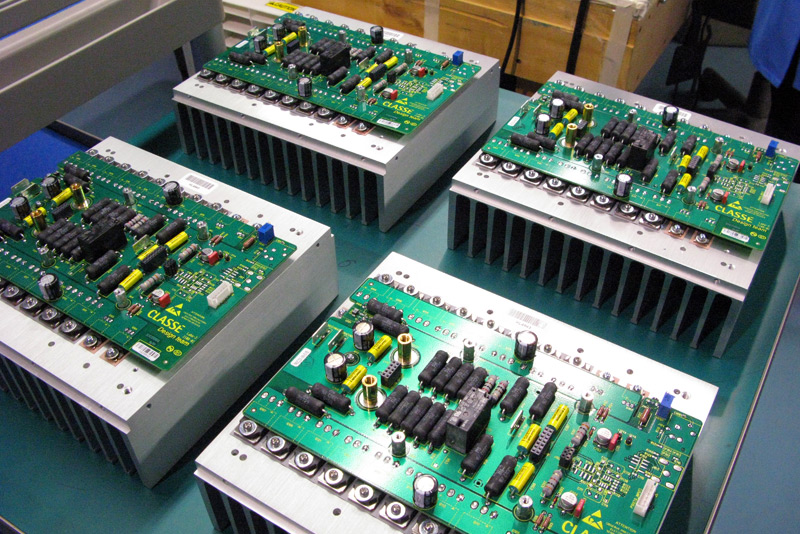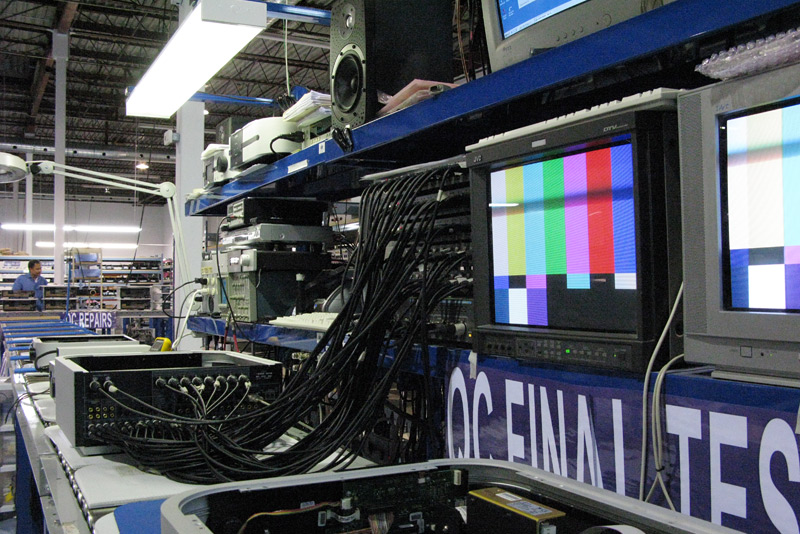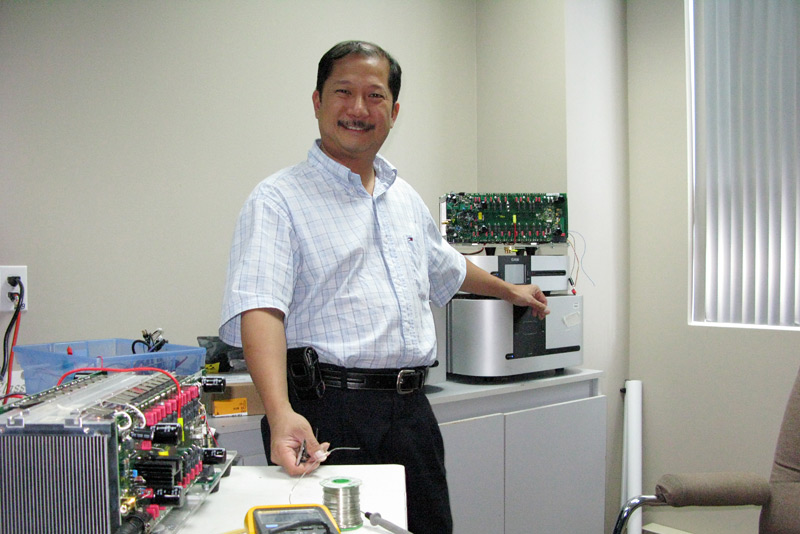 November 2008
Factory Tour: A Touch of
Classé
by Colin Smith
We audio reviewers are a fortunate bunch. Not
only do we get to play with all manner of audio gear, but we also get to meet quite a lot
of people in the audio business. You can learn a lot about a company by speaking with its
owners, engineers and management. But if you want to get the full perspective, you’ve
got to visit these folks at their factory, the place where creative inspiration becomes a
tangible product. We undertake such visits whenever possible, so when Soundstage! Network
publisher Doug Schneider and I were recently invited to tour the Classé Audio
facilities just outside Montreal, Canada, we didn’t hesitate to accept.

Classé Audio's main entrance.
Like the universe, Classé Audio began with a big
bang. As vice president Dave Nauber tells the story, back in 1980, company co-founder (and
current chairman) Mike Viglas was hosting a party at his Montreal home when suddenly one
of his amp’s output tubes failed in spectacular fashion. "Mike gets a kick out
of describing how people were picking little bits of vacuum tube out of their hair,"
says Dave. Sure, it seems funny now. But back then, the incident led Mike to
conclude that he needed a solid-state amp, if only to avoid peppering more guests with
tube shrapnel.
After fruitlessly auditioning every solid-state
design that local dealers could lay hands on, Mike was ready to give up when someone
suggested that he get in touch with a local amp designer, David Reich. This fellow was
rumored to be working on a solid-state design that would leave its contemporaries in the
dust. That must have been the case, because Mike not only bought an amp, he and Reich
decided to form Classé Audio. The new venture was named for Reich’s favored
amplifier topology, class A, and not, as you might expect from a Canadian company,
"Class, eh!"
With David’s designs and Mike’s
marketing savvy, Classé was built into a globally successful enterprise with a reputation
for designing great-sounding components. But, as often happens in life, over time the
founders began to have diverging views on the company’s direction. It was decided
that some major changes were in order, so, as the new millennium dawned, Mike Viglas went
looking for a new strategic partner.
He found one in 2001, when Classé became the
high-end electronics division of the Bowers & Wilkins Group, better known as B&W
Loudspeakers. Obviously B&W’s management liked what they saw at Classé because
it was decided that the Canadian division would remain a separate entity. However, in a
move which must have been very reassuring to Classé’s employees, the company was
also given responsibility for designing and assembling all the electronics used in
B&W’s products. For the present, this means that Classé builds subwoofer amps
and the electronics used in the B&W Zeppelin iPod dock. For the future, well, we
promised we wouldn’t tell.
With the infusion of B&W resources also came
Dave Nauber, who was educated as an electrical engineer and had been involved in the
management of the Madrigal group of companies. Dave’s first order of business was to
rally the Classé troops around the audacious goal of completely reinventing the company,
a task that was given the code name Project Delta. Dave told us that in engineering, the
term "delta" is used to denote the difference between one thing and another, and
so it was the perfect name for a new series of products that would mark the transition
from the old Classé to the new.
The Classé boardroom still shows signs of
Project Delta’s early days. No, there aren’t any holes in the walls! However,
there are a number of large posters, dated 2002, which show a variety of chassis studies
developed by an industrial-design firm in the UK. It must have been difficult to choose
the design that ultimately came to be the new face of Classé, because all of the studies
we saw were excellent. Incidentally, I’m not sure if Classé is aware of this, but
when I looked up the factory’s address on Google Maps, I couldn’t help but
notice that just a block away from the factory is a rail line that almost exactly follows
the contours of the design that came to be the Delta Series.
Dave pointed out to us that some of the chassis
designs showed the original Classé logo, while others featured variants then being
considered for the Delta Series. "We had six logo designs submitted to us. The
Classé logo we now use was the first one we rejected." Dave went on to say that
"The first thing I thought when I saw the logo is that a customer would think that a
piece of silkscreen had chipped off the top left corner of the ‘E.’" Of
course the "missing" piece actually stood in for the accent aigu that sits atop the "E," but people unfamiliar
with French grammar might not get the subtlety. So how did the "chipped
silkscreen" look make a comeback? "At the same time we were considering logos,
we hired a marketing specialist to come here and provide advice on some sales materials. I
e-mailed him all six logo designs and told him to use whichever one he liked on the sample
materials he was bringing."
A few weeks later, when the marketer began his
presentation, the Classé team was surprised to see that the sample materials featured the
logo they’d rejected. Dave told us that he stopped the presentation and asked the
expert why he’d chosen that particular logo. "Because," he told his
audience, "this logo does something that most aspire to do but few ever achieve:
It’s memorable. If you see it a second time, you’ll remember that you’ve
seen it before." And with that, the "chipped silkscreen" logo, along with
the flowing lines of the Delta chassis, became the symbols of the new Classé.
Of course, another unmistakably Classé symbol is
the touch-screen panel that adorns the front of each of the company’s Delta products.
When the touch panel was first suggested for the Delta Series, there was some concern that
such technology would be too expensive to integrate into Classé’s products. But
since the company was going for bold reinvention, Dave Nauber decided that they might as
well go all the way, and the touch screen was in.

A touch-screen-equipped CP-700 preamplifier goes
through final testing.
After a lunch of Montreal smoked-meat sandwiches
(what else?), our factory tour began in earnest. Before we were allowed on the assembly
floor, Doug and I had to don static-free lab coats and shoe straps that connected us to
the factory’s electrically grounded floor. Properly equipped, we were led by George
Ujhegyi, Classé’s manufacturing engineering manager, with Dave Nauber acting as
color commentator to George’s play-by-play description of the factory.

The main assembly area of Classé Audio's spacious
factory.
Our first stop was Engineering Support, where
prototyping work is done and where circuit boards are designed from blank sheets -- or
rather blank computer screens. Classé’s circuit boards aren’t laid out using
so-called auto-routing software because those don’t take signal-path purity into
account and simply find the most expeditious way from A to B. At Classé, each individual
copper trace is laid out by a technician on a computer and is tracked through its entire
length to ensure that sensitive signal paths do not come too close to power feeds. The
coolest tool we saw in engineering support was a thermal-imaging camera, which is used to
obtain a precise heat map of Classé components. The idea here is to catch any heat build
up in components during the prototyping phase so that any issues are rectified before a
product moves toward production. This, of course, is a great benefit for component
longevity.
Next, we proceeded to the extensive
quality-control (QC) area. It can be said without any reservation that Classé takes
quality control extremely seriously. Take, for example, the aforementioned
electrically grounded factory floor. This exists to protect delicate integrated circuits
(ICs) from static-electricity discharges. Dave Nauber explained that before they are
installed, ICs can be damaged by environmental stress. For example, even plastic ICs, he
said, can be susceptible to moisture damage. Therefore, Dave insists on a very tight
"chain of custody" for all the parts used in Classé products. The company only
does business with suppliers and shippers who follow proper handling and storage
procedures.
Based on what we saw in the QC area, it seems
unlikely that a faulty part will ever make it out of the Classé factory, unless it’s
in the garbage. During our visit the QC team was inspecting amplifier and control circuit
boards for the B&W Zeppelin iPod dock. Two technicians, properly grounded with wrist
straps, were inspecting each circuit board under magnifying lenses and bright lights,
looking for improperly installed parts and cleaning the boards. Once they passed visual
inspection, each board was mounted to a custom electrical jig and subjected to a battery
of tests by expensive electronic testing gear. If they make it past this phase, the boards
are packaged up and sent to B&W.

Inspecting Zeppelin circuit boards.
Of course, the QC procedures are just as
stringent for Classé-branded products. An interesting feature of the company’s QC
process is its use of bar codes on every single individual circuit board that makes up a
product. At each step of the QC process the bar code is scanned; this records not just the
date and time, but a complete history of the board and the parts used on it. If a board or
component fails anywhere along the assembly chain, its entire history can be called up and
a postmortem undertaken to understand where the failure occurred, and why. The bar codes
also prevent a board from skipping a step in the QC process. If, for example, step B has
been missed and a board somehow shows up at step C, the computer won’t allow work to
continue until the B test is finished. I asked George how long Classé keeps the QC
history for each of its products. His answer: They still have that information for the
first Classé amplifiers produced in 1981!
In the assembly area we saw quite a number of
amplifier output modules, destined for CA-M400 mono power amps, arrayed on a test rack.
Each amplifier board is run in at the factory for a minimum of 72 hours before it is
installed in a chassis. According to George Ujhegyi, this not only burns in the output
module (and its 16(!) output transistors), but it also allows the assembly technician to
bias the amplifier at full operating temperature, thereby ensuring that each amp is set up
properly. Awaiting these modules were a number of big CA-M400 chassis. Taking a look
inside one, I was amazed to see massive gold-plated copper bus bars that connect the
speaker binding posts to the output modules. The bars are so big that they’re bolted
to the binding posts, soldering not being an option on something so thick! Without
exaggeration, the things look like they could handle a lightning strike.

Output modules awaiting testing.
Our visit to the factory came just a few weeks
before the official launch of Classé’s new flagship SSP-800 preamp/processor.
I’m sure that the many customers who pre-ordered the $8000 device would be a little
envious to know that we saw dozens of these beauties lined up on shelves awaiting
packaging and shipment to their new homes. From what we saw of the SSP-800, it certainly
appears to be worth the wait. Look for a review of this new processor on a Soundstage!
Network website.
Speaking of the SSP-800, we also witnessed some
of these in front of a bank of equipment that might make NASA jealous, going through the
final QC test phase. Impressively, Classé tests every single input and output on every
one its components before the products are passed on to the shipping department.

Every input and output gets tested!
Believe it or not, the factory’s packaging
area was absolutely fascinating, because even Classé’s shipping cartons are products
of careful planning and attention to detail. The dense foam used to protect the precious
component is actually configurable, so that one size can be used for larger or smaller
components. The outer box is made from cardboard-like plastic and features handholds on
either end (other manufacturers, please take note!). The box lid also forms the sides of
the shipping container, so when it’s lifted off the base, the customer has easy,
360-degree access to the component because there are no side walls in the way. Anyone
who’s ever lifted a heavy amp out of a box would no doubt appreciate such
well-designed packaging. For reviewers, the Classé box is a dream come true. All of the
packaging is fully recyclable, but I can’t imagine why you’d want to throw away
such a nice box.

There's certainly pride in the packaging at Classé
Audio. That's George Ujhegyi on the left, David Nauber on the right.
Interestingly, even at this final stage of the
manufacturing process, the Classé barcode system shows its value. Here the codes are used
to ensure that the proper manual, power cable and remote control go into each box. Only
when the QC computer is satisfied that all is well does it authorize sealing up the box.
Though the shipping department may be the last
stop for Classé components, we still had one more department to visit. Often the most
interesting place in an audio factory is the research-and-development area, and this was
certainly the case here. Although we were sworn to secrecy, we can share a couple of
tidbits of information. First, Classé’s chief analog engineer, Nang Nguyen, proudly
displayed for us the distortion measurement of a new amplifier output stage he’s
working on. At a steady 100 watts of output power, the test gear reported an incredibly
low 0.0005% total harmonic distortion. That’s one more zero than you typically see
with an amplifier, or any other component for that matter. We can also report that Classé
is undertaking some beyond-the-cutting-edge work on power supplies. If all goes well, the
competition may soon find itself playing catch up.

Chief analog engineer Nang Nguyen.
Classé Audio’s success obviously
hasn’t happened by accident. Through careful planning, exquisite attention to detail,
and a dedicated and motivated workforce, Classé’s products have achieved critical
acclaim and a loyal following. Now that it has the resources of B&W behind it, and
with exciting new products entering production or going through development, it seems
certain that Classé will continue to push audio’s cutting edge ever forward. For the
"new" Classé Audio, it’s abundantly clear that the Delta Series is only
the beginning.
...Colin Smith
colins@soundstage.com
|

